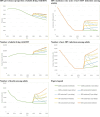This is a preprint.
Sustaining Rwanda's HIV response after elimination of PEPFAR funding: a modeling analysis
- PMID: 40313263
- PMCID: PMC12045445
- DOI: 10.1101/2025.04.25.25326450
Sustaining Rwanda's HIV response after elimination of PEPFAR funding: a modeling analysis
Abstract
Introduction: HIV prevention and treatment supported by the United States President's Emergency Plan for AIDS Relief (PEPFAR) have saved millions of lives. Rwanda is among the most successful countries around the world in achieving global targets with PEPFAR support. However, abrupt funding uncertainty around PEPFAR raises concerns about continued HIV epidemic control. We projected the impact of the Government of Rwanda's (GoR's) capacity to offset the elimination of PEPFAR funding on adult HIV epidemic and care continuum outcomes over 10 years.
Methods: Using an HIV policy model calibrated to Rwanda, we assessed: capacity to sustain HIV services at 50% (with no capacity by GoR to cover the PEPFAR funding gap), 75%, 90%, and 100% (with full capacity by GoR to cover the PEPFAR funding gap). Scenarios were operationalized by reducing the number on antiretroviral therapy (ART), with immediate ART discontinuation and proportional decreases in HIV diagnosis, ART initiation, and care re-engagement. We projected HIV epidemic outcomes (HIV prevalence, HIV incidence, number with HIV, new HIV infections, deaths) and care continuum outcomes (percent diagnosed, percent on ART among those diagnosed, percent virally suppressed among those on ART). We calculated differences in projected outcomes for partial or no capacity versus full capacity. Secondary analyses assessed delayed coverage capacity by 1 and 3 years.
Results: Compared to full capacity at 10 years, the model projected a 13.9%-38.7% increase in HIV prevalence and 69.0%-246.7% increase in HIV incidence across coverage capacity scenarios. This translated to 29,000-64,000 additional adults with HIV and 20,000-92,000 cumulative new adult HIV infections. Cumulative projected deaths increased by 10,000-51,200. The model projected continual reductions in percent diagnosed at 10 years; percent virally suppressed among those on ART was similar across scenarios. Higher, and more delayed, coverage capacity had projected outcomes similar to lower, and less delayed, coverage capacity.
Conclusions: Even in countries like Rwanda that have achieved epidemic control, abrupt and persistent elimination of PEPFAR funding could drastically reverse critical gains. Evidence quantifying the consequences of different capacities to sustain HIV services underscores the high stakes of rapid and sufficient action.
Keywords: HIV and AIDS; Rwanda; care continuum; epidemic; funding; mathematical model.
Conflict of interest statement
Competing interests The authors declare no competing interests.
Figures
Similar articles
-
Potential Clinical and Economic Impacts of Cutbacks in the President's Emergency Plan for AIDS Relief Program in South Africa : A Modeling Analysis.Ann Intern Med. 2025 Apr;178(4):457-467. doi: 10.7326/ANNALS-24-01104. Epub 2025 Feb 11. Ann Intern Med. 2025. PMID: 39932732
-
Evaluation of PEPFAR's Contribution (2012-2017) to Rwanda's Human Resources for Health Program.Washington (DC): National Academies Press (US); 2020 Feb 13. Washington (DC): National Academies Press (US); 2020 Feb 13. PMID: 32584529 Free Books & Documents. Review.
-
Estimating the impact of the US President's Emergency Plan for AIDS Relief on HIV treatment and prevention programmes in Africa.Sex Transm Infect. 2015 Dec;91(8):615-20. doi: 10.1136/sextrans-2014-051991. Epub 2015 Jun 8. Sex Transm Infect. 2015. PMID: 26056389
-
Impact of an international HIV funding crisis on HIV infections and mortality in low-income and middle-income countries: a modelling study.Lancet HIV. 2025 May;12(5):e346-e354. doi: 10.1016/S2352-3018(25)00074-8. Epub 2025 Mar 26. Lancet HIV. 2025. PMID: 40157378
-
Ghana's HIV epidemic and PEPFAR's contribution towards epidemic control.Ghana Med J. 2019 Mar;53(1):59-62. doi: 10.4314/gmj.v53i1.9. Ghana Med J. 2019. PMID: 31138945 Free PMC article. Review.
References
-
- Joint United Nations Programme on HIV/AIDS. AIDSinfo: Global data on HIV epidimiology and response 2024. [cited 2025 March 21]. Available from: https://aidsinfo.unaids.org/.
-
- Rwanda Ministry of Health. National HIV/AIDS targets: 2018–2020-20302015 [cited 2025 March 21]. Available from: https://rbc.gov.rw/IMG/pdf/rwanda_hiv_aids_2020_and_2030_targets.pdf.
-
- Joint United Nations Programme on HIV/AIDS. HIV sustainability planning: Analytical resource2024 [cited 2025 March 21]. Available from: https://sustainability.unaids.org/wp-content/uploads/2024/08/Rwanda__-Ex....
-
- Joint United Nations Programme on HIV/AIDS. Impact of US funding cuts on HIV programmes in Rwanda 2025. [Available from: https://www.unaids.org/en/resources/presscentre/featurestories/2025/marc....
-
- Center CfDCaPGH. CDC in Rwanda: HIV and TB 2024. [cited 2025 April 15]. Available from: https://www.cdc.gov/global-health/countries/rwanda.html#cdc_generic_sect....
Publication types
Grants and funding
LinkOut - more resources
Full Text Sources
Miscellaneous


